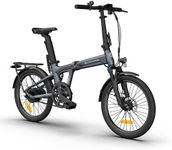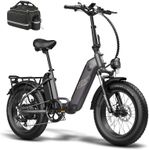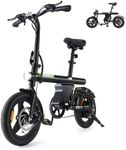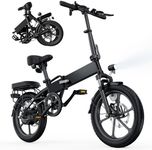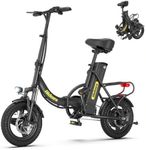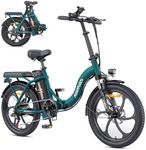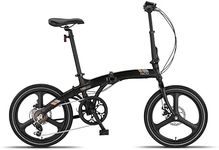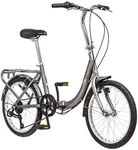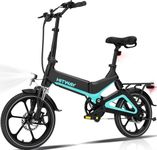Buying Guide for the Best Folding Bikes
Folding bikes are a fantastic solution for those who need a compact and portable mode of transportation. They are ideal for city dwellers, commuters, or anyone with limited storage space. When choosing a folding bike, it's important to consider how and where you'll be using it, as well as your personal preferences for comfort and convenience. Understanding the key specifications will help you make an informed decision that best suits your lifestyle and needs.Folded SizeFolded size refers to the dimensions of the bike when it is fully folded. This is important because it determines how easily you can store or transport the bike. If you have limited space at home or need to carry the bike on public transport, a smaller folded size is preferable. Generally, folding bikes can be categorized into compact, medium, and large folded sizes. Compact sizes are great for tight spaces, while larger sizes might offer more comfort when riding but require more storage space. Consider where you will store the bike and how often you will need to carry it when choosing the right folded size for you.
WeightThe weight of a folding bike is crucial, especially if you plan to carry it frequently. A lighter bike is easier to transport and handle, making it ideal for commuters who need to carry the bike on public transport or up stairs. Folding bikes typically range from lightweight models, which are under 25 pounds, to heavier models that can weigh over 30 pounds. If you need to carry the bike often, opt for a lighter model. However, if you prioritize durability and stability over portability, a slightly heavier bike might be more suitable.
Wheel SizeWheel size affects the ride quality and portability of a folding bike. Smaller wheels, such as 16-inch or 20-inch, make the bike more compact and easier to fold, which is great for storage and transport. However, they may not handle rough terrain as well as larger wheels. Larger wheels, like 24-inch or 26-inch, provide a smoother ride and better performance on uneven surfaces but result in a larger folded size. Consider the type of terrain you will be riding on and how important portability is to you when selecting the wheel size.
Frame MaterialThe frame material of a folding bike impacts its weight, durability, and cost. Common materials include steel, aluminum, and carbon fiber. Steel frames are strong and durable but tend to be heavier. Aluminum frames are lighter and resistant to rust, making them a popular choice for commuters. Carbon fiber frames are the lightest and offer excellent performance but are usually more expensive. Choose a frame material based on your priorities: if you need a lightweight bike for easy carrying, aluminum or carbon fiber might be best, while steel is a good choice for durability and cost-effectiveness.
GearingGearing refers to the number of speeds or gears a folding bike has, which affects how easy it is to ride on different terrains. Bikes with more gears offer greater versatility, allowing you to tackle hills and ride at various speeds. Folding bikes can have anywhere from a single speed to 21 or more gears. If you plan to ride on flat surfaces or short distances, a single-speed or a bike with fewer gears might suffice. For hilly areas or longer commutes, consider a bike with more gears to make your ride more comfortable and efficient.
Folding MechanismThe folding mechanism determines how quickly and easily you can fold and unfold the bike. There are several types of folding mechanisms, including half-fold, vertical fold, and triangle hinge. A simple and quick folding mechanism is ideal for those who need to fold and unfold the bike frequently, such as commuters. However, some mechanisms might offer a more compact fold or better stability when riding. Consider how often you will need to fold the bike and how important ease of use is to you when evaluating the folding mechanism.
